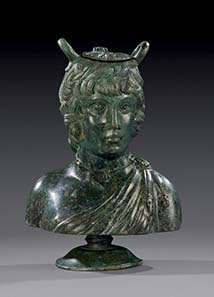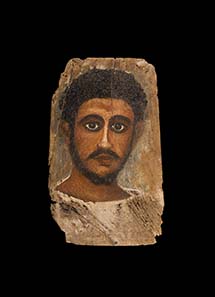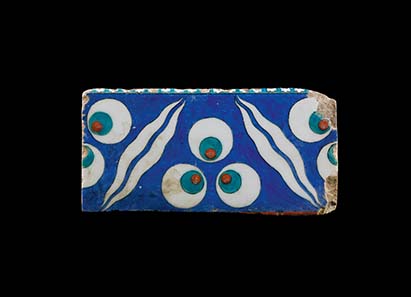28-06-2011 – 01-01-1970
Auction 198 – Antiquities
Antinoos, Miltiades, Topkapi & Co.: top-class offer reached top-class prices at Gorny & Mosch
At the end of June, the time had come again: Gorny & Mosch invited all admirers of ancient art to participate in theired latest auction in Munich. The numerous collectors showing up were rewarded, that is for sure: high-quality objects, numerous rarities and hot bidding fights made it a memorable day.
No. 1: Antinoos-balsamarium. Bronze hollow casting, Roman, 2rd cent. A. D. H 21 cm. Estimate: 35,000 Euros. Price realized: 97,750 Euros.
Let’s recall the most beautiful objects. Who would have guessed that already the first catalog number, which by the way didn’t have the highest estimate of the auction, exceeded any expectations? It was a bronze balsamarium in the shape of an Antinoos bust with a gorgeous green patina that rose from its estimate of 35,000 Euros to, believe it or not, 97.750 Euros* (no. 1). Some might have held their breath – however, there was no time to pause for breath since, after all, this was the “Special Objects” section containing by tradition only the best and most beautiful offers of Gorny & Mosch’s. Hence, one highlight followed the other: after the return of the standards, which had fallen into the hands of the Parthians in the ill-fated campaign of Crassus, Augustus had consecrated a temple to Mars Ultor, the avenging war god of the Romans. A bronze statuette sculpted after the original cult statue brought 41,400 Euros on its estimate of “only” 20,000 Euro (no. 3). Let’s turn from Roman Imperial times to the period of early High Civilizations of the Eastern Mediterranean. During this time, more than 4,000 years ago, a Cycladic idol was made, impressive in its unpretentious majesty, modestly estimated at 7,500 Euros (no. 8). The end result was 50,600 Euros, six times the estimation!
Miltiades – that was how famous archeologist Gisela M. A. Richter identified a replica of the marble portrait head offered with no. 11. The fragment shows an elderly man with impressive facial features: finest sculptural work, with great care to details – the piece can hardly be described otherwise. Its new owner had to pay 48,300 Euros, which made the price exceed the estimate of 15,000 Euros more than three times.
No. 12: Traianus Decius (?). Marble, middle of 3rd cent. A. D. H 26 cm. Estimate: 50,000 Euros. Price realized: 63,250 Euros.
Equally spectacular but from an entirely different stylistic era was a Roman portrait head of marble reminding of Emperor Traianus Decius from the middle of the 3rd cent. A. D. (no. 12). In the end, the price was no less than 63,250 Euros.
Antonia minor, daughter of Marc Antony and Octavia, Augustus’s sister, was one of the most colorful female figures of the early Roman Empire. A marble head with her typical likeness achieved 55,200 Euros (no. 13). Two centuries later, a noble lady immortalized herself in marble. Her fashionable coiffure recalls Julia Domna, wife of Septimius Severus. Her bust soon left its estimate of 25,000 Euros behind and eventually changed hands for 41,400 Euros (no. 14).
No. 50: Mummy portrait. Egypt, 3rd cent. A. D. Portrait of a young man with curly hair and beard. 34.5 x 21. cm. Estimate: 18,000 Euros. Price realized: 69,000 Euros.
Not only ancient sculpture reached spectacular results. Highlights were to be found in almost every section of ancient art. A Phrygian bronze helmet in its characteristic shape, seldom found in this good preservation, found a new home for impressive 57,500 Euros (no. 40, estimate: 35,000 Euros). An Egyptian mummy portrait of a bearded man originating from the 3rd cent. A. D. climbed from its estimate of 18,000 Euros to 69,000 Euros, i.e. three and a half times the estimate (no. 50). 46,000 Euros a collector paid for a literally royal gem, a gold fibula with nicely sculpted ornaments with a garnet inserted showing the likeness of a Hellenistic ruler (no. 52).
The “Special Objects” are followed by the “ordinary objects”, one may assume jestingly. Far from it since the pieces, assembled according to art genres, were abundant in highlights. Like a blue glass bowl whose simple elegance made the price of estimated 20,000 Euros rising to 43,700 Euros (no. 94). Or the early Classical juvenile head with its stylistic resemblance to the famous pediment sculptures of the Temple of Zeus in Olympia, that reached more than five times its estimate (no. 236: 4,000 / 23,000 Euros). Not to forget a bronze statuette of the Roman goddess Virtus: casting a spell on several collectors at once, its price exceeded its estimate of 1,700 Euros more than six times and reached 11,000 Euros in the end (no. 255).
No. 519: Iznik tile with cintamani. Ottoman Empire, c. 1580. 25 x 12 cm. Estimate: 1,000 Euros. Price realized: 34.500 Euro.
A surprise was caused by an Iznik tile – mass produced good to the layman, but a special object to the connoisseur since another tile in London, being similar in its measures and decoration, had been identified as an element of decoration of Topkapi Palace. Its estimate was 1,000 Euros but then the bell tolled for the experts and the rare piece was sold for 34,500 Euros (no. 519). Seven Islamic glass tiles, dating from 8th to 10th century, reached a similar result: 36,800 Euros on estimated 3,500 Euros (no. 520)!
Buyers’ interest continued to be great until the end: a throne with Byzantine architectural elements likewise truly set an exclamation mark with its price of 52,900 Euros (no. 568, estimate: 30,000 Euros).
As always, list of prices realized and catalogs can be viewed at www.gmcoinart.de. The next auction of antiquities is scheduled for December.
* All prices include 15 % buyer’s premium.








